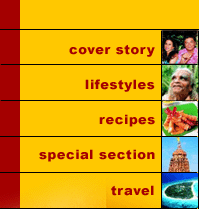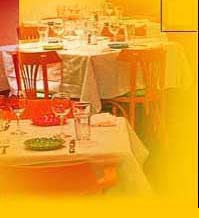


 Importing India To London
Importing India To London
Namita Panjabi While other restaurateurs in UK import food ingredients from India, Namita imports the chefs, wholesale, that is why she provides the most authentic Indian food in London, and food that ranges over several regions.
|
|
NAMITA PANJABI was once a merchant banker and is now a full-time restaurateur. Chutney Mary and its sister Veeraswamy, London�s India portals, are her restaurants; they combine Indian food with style and are at the top end of the restaurant market in the UK. Their new sibling, Masala Zone, has also taken London by storm, and Namita serves simpler but real Indian food here at throwaway prices. She opened Masala Zone in 2001, a fun, innovative and casual Indian restaurant located in the heart of Soho, that has been a hit with the critics.
While other restaurateurs in UK import food ingredients from India, Namita imports the chefs, wholesale, that is why she provides the most authentic Indian food in London, and food that ranges over several regions. In a country with over 9,000 curry houses, Chutney Mary and Veeraswamy stand out. They have been in the Good Curry Guide and Chutney Mary is rated as being London�s most fashionable and highly acclaimed Indian restaurant. It received the award of Best Indian Restaurant in the UK twice.
Namita�s missionary objective is to create restaurants in the UK serving the exciting tastes of the many regions of India, combined with style, flair, and presentation. She has had a lifelong passion for real Indian food, and has travelled throughout the length and breadth of India to find it. Chutney Mary, Veeraswamy and Masala Zone differ radically from most other Indian restaurants whether in Britain or India because their dishes are from the homes of regional gourmet families, Maharajas� palaces, and humble wayside stalls.
Namita picks her kitchen staff by trying them out from national talent, selects, and flies them over to London, lodges them in rooms with baths in Chelsea. No wonder Chutney Mary has been a success since the day it opened in 1990. The normal system is to take over somebody�s running restaurant, renovate it and run it, banking on the goodwill of the old restaurant. But goodwill costs millions of pounds, according to Namita. So she and her investment-banker husband Ranjit Mathrani opened a brand new restaurant in Chelsea, a nice residential area but not a restaurant
destination, and began from scratch.
It has Anglo-Indian paintings on the walls (perhaps that is the derivative for the name), 130 covers, including a garden conservatory at courtyard level, walled all round by glass. The service is plated, it is best for Indian food. Till the Chutney Mary came along, Indian food in England was largely Punjabi. The kitchens had three pots, one carried a makhni sauce, another a brown onion sauce and the third a white almond gravy. Whatever the order, the appropriate gravy was added to it and served.
First, she introduced food from all regions, or most regions, Goa, Hyderabad, Kerala, Chettinad, Delhi, with a chef for each region. And if a particular chef was absent, that region�s food was not on the menu on that day. And she changed the three pot philosophy. If there were 22 curries on the menu, there were 22 pots bubbling away in the kitchen.
Veeraswamy is a comparatively new acquisition, though the restaurant itself is registered as the oldest Indian restaurant in England. It stands at the end of Regent Street, very near Piccadilly, and has a kind of British Empire history that Englishmen love to hear and get sentimental over. Edward Palmer, an Anglo-Indian, whose great-grandfather was principal secretary to Warren Hastings and great-grandmother an Indian princess, went to see India when he was 20 years old, returned the following year (1926) and started Veeraswamy.
In the old days, its customers ranged from the Maharaja of Baroda to the King of Denmark (duck vindaloo and Carlsberg beer), Pandit Nehru ate there, Krishna Menon, and it was customary for Indians visiting London to spend the first day in town resting and the second day dining at Veeraswamy. Since then, the restaurant had changed hands two or three times and was a little down in the dumps. That�s when Namita Panjabi and Ranjit Mathrani bought it over � a mistake, said the English restaurant critics.
Not so, the new owners gave the place lacquered walls, vibrant colours of Kanjeeveram silk saris, orange, mustard gold, emerald green, purple, South Indian artefacts set against hand-blasted glass, a collection of Kerala locks. Best of all, it has a collection of wines in a huge wine display. And the wines have been helpfully sorted out to go with Indian food. A White Vina Porta Chardonnay from Chile, with flavour, fruit and character, to go with the medium spiced dishes, and full flavoured Red Roolberg Winery Pinotage from South Africa to accompany the spiciest (the Manglorean Kori Gassi, the chicken done in roasted spices, for instance). A very impressive and exhaustive list.
More original are some of the individual cocktails, a Mango Daiquiri (white, lime juice and mango pulp), and a Masala Bloody Mary � the masala is in the tomato juice. Also enjoyable is the manner in which some of the starters are described. Steamed rice cakes and spicy lentil curry is idli sambar, and puffed crispy wheat biscuits with lentil, potato and a chilled tangy tamarind cocktail, is pani puri. The food is more or less common to both the restaurants, four to five dishes per region and each with its individual chef.
Worthy of mention is a seafood moilee, the delicately flavoured curry from Kerala, with fresh flaked crab, mussels, prawns, calamari and salmon. And you are always assured a fresh seabass in a red Goa masala. And some select desserts, recommended: A banana kulfi with bitter chocolate, gulab jamuns flambed in brandy, and mawa samoosas with vanilla ice-cream. Small wonder London�s become the food capital of the world.
|

Home Page
About the mag
Subscribe
Advertise
Contact Us